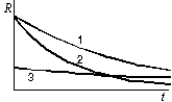A) 15 minutes
B) 5 minutes
C) 7 minutes
D) 3.75 minutes
E) 10 minutes
Correct Answer

verified
Correct Answer
verified
Multiple Choice
Magnesium has atomic number 12, hydrogen has atomic number 1, and helium has atomic number 2. In the nuclear reaction 24Mg + 2H ( ) + 4He the missing quantity is:
A) 23Na (Z = 11)
B) 22Ne (Z = 10)
C) 21Na (Z = 11)
D) 21Ne (Z = 10)
E) 22Na (Z = 11)
Correct Answer

verified
Correct Answer
verified
Multiple Choice
A femtometer is:
A) larger than 10-9 m
B) 10-9 m
C) 10-12 m
D) 10-15 m
E) 10-18 m
Correct Answer

verified
Correct Answer
verified
Multiple Choice
At the end of 14 min, 1/16 of a sample of radioactive polonium remains. The corresponding half-life is:
A) (7/8) min
B) (8/7) min
C) (7/4) min
D) (7/2) min
E) (14/3) min
Correct Answer

verified
Correct Answer
verified
Multiple Choice
210Bi (an isotope of bismuth) has a half-life of 5.0 days. The time for three-quarters of a sample of 210Bi to decay is:
A) 2.5 days
B) 10 days
C) 15 days
D) 20 days
E) 3.75 days
Correct Answer

verified
Correct Answer
verified
Multiple Choice
A nucleus with a mass number of 64 has a mean radius of about:
A) 4.8 fm
B) 19 fm
C) 77 fm
D) 260 fm
E) 2.6* 105 fm
Correct Answer

verified
Correct Answer
verified
Multiple Choice
A proton in a large nucleus:
A) attracts all other protons
B) repels all other protons
C) repels all neutrons
D) attracts some protons and repels others
E) attracts some neutrons and repels others
Correct Answer

verified
Correct Answer
verified
Multiple Choice
The mass of a neutron:
A) equals that of an electron
B) equals that of a proton
C) is a little more than that of a proton
D) is exactly that of a proton plus an electron
E) is as yet unmeasured
Correct Answer

verified
Correct Answer
verified
Multiple Choice
A radium atom, 226Ra (Z = 86) , emits an alpha particle. The number of protons in the resulting atom is:
A) 84
B) 85
C) 86
D) 88
E) some other number
Correct Answer

verified
Correct Answer
verified
Multiple Choice
Volumes of atomic nuclei are proportional to:
A) the mass number
B) the atomic number
C) the total nuclear spin
D) the number of neutrons
E) none of these
Correct Answer

verified
Correct Answer
verified
Multiple Choice
Aluminum has atomic number 13, helium has atomic number 2, and silicon has atomic number 14. In the nuclear reaction 27Al + 4He 30Si + ( ) the missing particle is:
A) an particle
B) a positron
C) a electron
D) proton
E) neutron
Correct Answer

verified
D
Correct Answer
verified
Multiple Choice
The graph shows the activity R as a function of the time t for three radioactive samples. Rank the samples according to their half-lives, shortest to longest. 
A) 1, 2 ,3
B) 1, 3, 2
C) 2, 1, 3
D) 2, 3, 1
E) 3, 1, 2
Correct Answer

verified
Correct Answer
verified
Multiple Choice
Some alpha emitters have longer half-lives than others because:
A) their alpha particles have greater mass
B) their alpha particles have less mass
C) their barriers to decay are higher and wider
D) their barriers to decay are lower and narrower
E) their decays include the emission of a photon
Correct Answer

verified
Correct Answer
verified
Multiple Choice
The smallest particle of any chemical element that can exist by itself and yet retain the qualities that distinguish it as that element is:
A) an electron
B) a proton
C) a neutron
D) an atom
E) a molecule
Correct Answer

verified
Correct Answer
verified
Multiple Choice
Radioactive 90Sr has a half-life of 30 years. What percent of a sample of 90Sr will remain after 60 years?
A) 0%
B) 25%
C) 50%
D) 75%
E) 14%
Correct Answer

verified
B
Correct Answer
verified
Multiple Choice
The atomic number of an element is:
A) the whole number nearest to its mass
B) the number of protons in its nucleus
C) the nearest whole number of hydrogen atoms having the same mass as a single atom of the given element
D) the number of neutrons in its nucleus
E) its order of discovery
Correct Answer

verified
Correct Answer
verified
Multiple Choice
Let Z denote the atomic number and A denote the mass number of a nucleus. The number of neutrons in this nucleus is:
A) Z
B) A - Z
C) A - 2Z
D) A
E) 2A - Z
Correct Answer

verified
B
Correct Answer
verified
Multiple Choice
Of the three common types of radiation (alpha, beta, gamma) from radioactive sources, electric charge is carried by:
A) only beta and gamma
B) only beta
C) only alpha and gamma
D) only alpha
E) only alpha and beta
Correct Answer

verified
Correct Answer
verified
Multiple Choice
Bromine, with atomic mass 79.942 u, is composed of nearly equal amounts of two isotopes, one of which contains 79 nucleons per atom. The mass number of the other isotope is:
A) 78
B) 79
C) 80
D) 81
E) 82
Correct Answer

verified
Correct Answer
verified
Multiple Choice
The isotopes of an element:
A) cannot be separated at all
B) occur well separated in nature
C) have similar chemical behavior
D) cannot be separated by physical methods
E) have equal masses
Correct Answer

verified
Correct Answer
verified
Showing 1 - 20 of 67
Related Exams